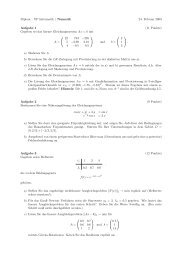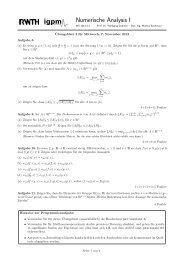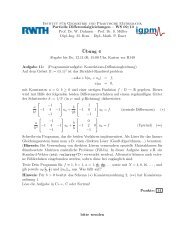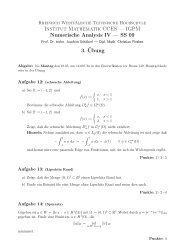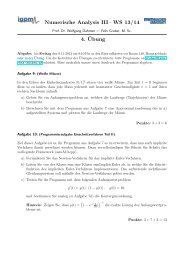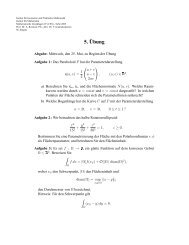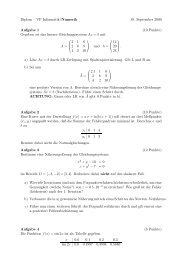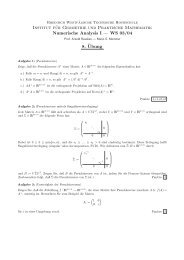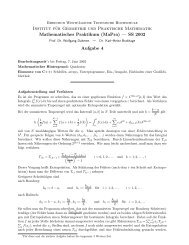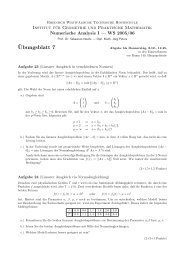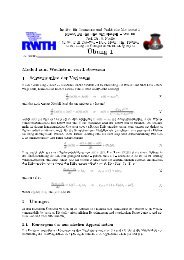The Reduced Basis Method Problem Set 1
The Reduced Basis Method Problem Set 1
The Reduced Basis Method Problem Set 1
You also want an ePaper? Increase the reach of your titles
YUMPU automatically turns print PDFs into web optimized ePapers that Google loves.
Model Order Reduction Techniques I:<br />
<strong>The</strong> <strong>Reduced</strong> <strong>Basis</strong> <strong>Method</strong><br />
<strong>Problem</strong> <strong>Set</strong> 1 – Linear Affine Elliptic <strong>Problem</strong>s<br />
Summer Term 2010, handed out 27.04.2010<br />
<strong>Problem</strong> Statement – Design of a <strong>The</strong>rmal Fin<br />
We consider the problem of designing a thermal fin to effectively remove heat from a surface.<br />
<strong>The</strong> two-dimensional fin, shown in Figure 1, consists of a vertical central “post” and four horizontal<br />
“subfins”; the fin conducts heat from a prescribed uniform flux “source” at the root, Γ root , through<br />
the large-surface-area subfins to surrounding flowing air.<br />
<strong>The</strong> fin is characterized by a five-component parameter vector, or “input,” µ = (µ 1 , µ 2 , . . . , µ 5 ),<br />
where µ i = k i , i = 1, . . . , 4, and µ 5 = Bi; µ may take on any value in a specified design set D ⊂ R 5 .<br />
Here k i is the thermal conductivity of the i th subfin (normalized relative to the post conductivity<br />
k 0 ≡ 1); and Bi is the Biot number, a nondimensional heat transfer coefficient reflecting convective<br />
transport to the air at the fin surfaces (larger Bi means better heat transfer). For example, suppose<br />
we choose a thermal fin with k 1 = 0.4, k 2 = 0.6, k 3 = 0.8, k 4 = 1.2, and Bi = 0.1; for this particular<br />
configuration µ = {0.4, 0.6, 0.8, 1.2, 0.1}, which corresponds to a single point in the set of all<br />
possible configurations D (the parameter or design set). <strong>The</strong> post is of width unity and height four;<br />
the subfins are of fixed thickness t = 0.25 and length L = 2.5.<br />
We are interested in the design of this thermal<br />
fin, and we thus need to look at certain<br />
outputs or cost-functionals of the temperature<br />
as a function of µ. We choose for our output<br />
T root , the average steady-state temperature of<br />
the fin root normalized by the prescribed heat<br />
flux into the fin root. <strong>The</strong> particular output<br />
chosen relates directly to the cooling efficiency<br />
of the fin — lower values of T root imply better<br />
thermal performance.<br />
<strong>The</strong> steady–state temperature distribution<br />
Figure 1: <strong>The</strong>rmal Fin<br />
within the fin, u(µ), is governed by the elliptic partial differential equation<br />
−k i ∇ 2 u i = 0 in Ω i , i = 0, . . . , 4, (1)<br />
where ∇ 2 is the Laplacian operator, and u i refers to the restriction of u to Ω i . Here Ω i is the region<br />
of the fin with conductivity k i , i = 0, . . . , 4: Ω 0 is thus the central post, and Ω i , i = 1, . . . , 4,<br />
corresponds to the four subfins. <strong>The</strong> entire fin domain is denoted Ω (¯Ω = ∪ 4 i=0 ¯Ω i ); the boundary<br />
Ω is denoted Γ. We must also ensure continuity of temperature and heat flux at the conductivity–<br />
1
discontinuity interfaces Γ i int ≡ ∂Ω0 ∩ ∂Ω i , i = 1, . . . , 4, where ∂Ω i denotes the boundary of Ω i :<br />
u 0 = u i<br />
−(∇u 0 · ˆn i ) = −k i (∇u i · ˆn i )<br />
}<br />
on Γ i int, i = 1, . . . , 4;<br />
here ˆn i is the outward normal on ∂Ω i . Finally, we introduce a Neumann flux boundary condition<br />
on the fin root<br />
−(∇u 0 · ˆn 0 ) = −1 on Γ root , (2)<br />
which models the heat source; and a Robin boundary condition<br />
−k i (∇u i · ˆn i ) = Bi u i on Γ i ext , i = 0, . . . , 4, (3)<br />
which models the convective heat losses. Here Γ i ext is that part of the boundary of Ωi exposed to<br />
the flowing fluid; note that ∪ 4 i=0Γ i ext = Γ\Γ root.<br />
<strong>The</strong> average temperature at the root, T root (µ), can then be expressed as l O (u(µ)), where<br />
∫<br />
l O (v) = v<br />
Γ root<br />
(recall Γ root is of length unity). Note that l(v) = l O (v) for this problem.<br />
Part 1 - Finite Element Approximation<br />
We saw in class that the reduced basis approximation is based on a “truth” finite element<br />
approximation of the exact (or analytic) problem statement. To begin, we have to show that the<br />
exact problem described above does indeed satisfy the affine parameter dependence and thus fits<br />
into the framework shown in class.<br />
α) Show that u e (µ) ∈ X e ≡ H 1 (Ω) satisfies the weak form<br />
a(u e (µ), v; µ) = l(v), ∀v ∈ X e , (4)<br />
with<br />
a(w, v; µ) =<br />
l(v) =<br />
4∑<br />
∫<br />
k i ∇w · ∇v dA + Bi wv dS,<br />
i=0<br />
∫Ω i Γ\Γ root<br />
∫<br />
v dS.<br />
Γ root<br />
β) Optional: show that u e (µ) is the argument that minimizes<br />
J(w) = 1 2<br />
4∑<br />
∫<br />
k i<br />
i=0<br />
∇w · ∇w dA + Bi<br />
Ω i 2<br />
∫<br />
Γ\Γ root<br />
∫<br />
w 2 dS − w dS (5)<br />
Γ root<br />
over all functions w in X e .<br />
We now consider the linear finite element space<br />
X N = {v ∈ H 1 (Ω)| v| Th ∈ IP 1 (T h ), ∀T h ∈ T h },<br />
2
and look for u N (µ) ∈ X N such that<br />
our output of interest is then given by<br />
a(u N (µ), v; µ) = l(v), ∀v ∈ X N ; (6)<br />
Applying our usual nodal basis, we arrive at the matrix equations<br />
T N root (µ) = lO (u N (µ)). (7)<br />
A N (µ) u N (µ) = F N ,<br />
T N root (µ) = (LN ) T u N (µ),<br />
where A N ∈ R N ×N , u N ∈ R N , F N ∈ R N , and L N ∈ R N ; here N is the dimension of the finite<br />
element space X N , which (given our natural boundary conditions) is equal to the number of nodes<br />
in T h .<br />
Part 2 - <strong>Reduced</strong>-<strong>Basis</strong> Approximation<br />
In general, the dimension of the finite element space, dim X = N , will be quite large (in<br />
particular if we were to treat the more realistic three-dimensional fin problem), and thus the solution<br />
of A N u N (µ) = F N can be quite expensive. We thus investigate the reduced-basis methods that allow<br />
us to accurately and very rapidly predict T root (µ) in the limit of many evaluations — that is, at<br />
many different values of µ — which is precisely the “limit of interest” in design and optimization<br />
studies. To derive the reduced-basis approximation we shall exploit the energy principle,<br />
u(µ) = arg min<br />
w∈X J(w),<br />
where J(w) is given by (5).<br />
To begin, we introduce a sample in parameter space,<br />
S N = {µ 1 , µ 2 , . . . , µ N }<br />
with N ≪ N . Each µ i , i = 1, . . . , N, belongs in the parameter set D. For our parameter set we<br />
choose D = [0.1, 10.0] 4 × [0.01, 1.0], that is, 0.1 ≤ k i ≤ 10.0, i = 1, . . . , 4, for the conductivities, and<br />
0.01 ≤ Bi ≤ 1.0 for the Biot number.<br />
We then introduce the reduced-basis space as<br />
W N = span{u N (µ 1 ), u N (µ 2 ), . . . , u N (µ N )} (8)<br />
where u N (µ i ) is the finite-element solution for µ = µ i . To simplify the notation, we define ζ i ∈ X<br />
as<br />
ζ i = u N (µ i ), i = 1, . . . , N;<br />
we can then write W N = span{ζ i , i = 1, . . . , N}. Recall that W N = span{ζ i , i = 1, . . . , N} means<br />
that W N consists of all functions in X that can be expressed as a linear combination of the ζ i ; that<br />
is, any member v N of W N can be represented as<br />
v N =<br />
N∑<br />
β j ζ j , (9)<br />
j=1<br />
3
for some unique choice of β j ∈ R, j = 1, . . . , N. (We implicitly assume that the ζ i , i = 1, . . . , N,<br />
are linearly independent; it follows that W N is an N-dimensional subspace of X N .)<br />
In the reduced-basis approach we look for an approximation u N (µ) to u N (µ) (which for our<br />
purposes here we presume is arbitrarily close to u e (µ)) in W N ; in particular, we express u N (µ) as<br />
u N (µ) =<br />
N∑<br />
u j N ζj ; (10)<br />
j=1<br />
we denote by u N (µ) ∈ R N the coefficient vector (u 1 N , . . . , uN N )T . <strong>The</strong> premise — or hope — is that<br />
we should be able to accurately represent the solution at some new point in parameter space, µ, as<br />
an appropriate linear combination of solutions previously computed at a small number of points in<br />
parameter space (the µ i , i = 1, . . . , N). But how do we find this appropriate linear combination?<br />
And how good is it? And how do we compute our approximation efficiently?<br />
<strong>The</strong> energy principle is crucial here (though more generally the weak form would suffice). To<br />
wit, we apply the classical Rayleigh-Ritz procedure to define<br />
u N (µ) = arg<br />
min J(w N ); (11)<br />
w N ∈W N<br />
alternatively we can apply Galerkin projection to obtain the equivalent statement<br />
<strong>The</strong> output can then be calculated from<br />
We now study this approximation in more detail.<br />
α) Prove that, in the energy norm || · || ≡ (a(·, ·; µ)) 1/2 ,<br />
a(u N (µ), v; µ) = l(v), ∀v ∈ W N . (12)<br />
T root N (µ) = l O (u N (µ)). (13)<br />
||u(µ) − u N (µ)|| ≤ ||u(µ) − w N ||, ∀w N ∈ W N . (14)<br />
This inequality indicates that out of all the possible choices of w N in the space W N , the reducedbasis<br />
method defined above will choose the “best one” (in the energy norm). Equivalently, we can<br />
say that even if we knew the solution u(µ), we would not be able to find a better approximation to<br />
u(µ) in W N — in the energy norm — than u N (µ).<br />
β) Prove that<br />
T root (µ) − T root N (µ) = ||u(µ) − u N (µ)|| 2 . (15)<br />
γ) Show that u N (µ) as defined in (10–12) satisfies a set of N × N linear equations,<br />
A N (µ)u N (µ) = F N ;<br />
and that<br />
T root N (µ) = L T N u N (µ).<br />
Give expressions for A N (µ) ∈ R N×N in terms of A N (µ) and Z, F N ∈ R N in terms of F N and Z,<br />
and L N ∈ R N in terms of L N and Z; here Z is an N × N matrix, the j th column of which is u N (µ j )<br />
(the nodal values of u N (µ j )).<br />
4
δ) Show that the bilinear form a(w, v; µ) can be decomposed as<br />
a(w, v; µ) =<br />
Q∑<br />
Θ q (µ)a q (w, v), ∀w, v ∈ X, ∀µ ∈ D, (16)<br />
q=1<br />
for Q = 6; and give expressions for the Θ q (µ) and the a q (w, v). Notice that the a q (w, v) are not<br />
dependent on µ; the parameter dependence enters only through the functions Θ q (µ), q = 1, . . . , Q.<br />
Further show that<br />
Q∑<br />
A N (µ) = Θ q (µ)A N q ,<br />
and<br />
A N (µ) =<br />
q=1<br />
Q∑<br />
Θ q (µ)A q N . (17)<br />
q=1<br />
Give an expression for the A N q in terms of the nodal basis functions; and develop a formula for the<br />
A q N in terms of the AN q and Z.<br />
Acknowledgment: This problem set is heavily based on a problem set in the class “16.920 Numerical<br />
<strong>Method</strong>s for Partial Differential Equations” at MIT. Thanks to Prof. A.T. Patera and Debbie<br />
Blanchard for providing the necessary material and for allowing us to use it.<br />
5



